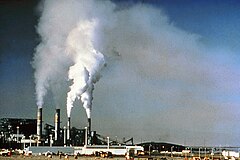Air Pollution Control Act of 1955
[2] The act "left states principally in charge of prevention and control of air pollution at the source".
The Air Pollution Control Act was the culmination of much research done on fuel emissions by the federal government in the 1930s and 1940s.
A decade later the Motor Vehicle Air Pollution Control Act was enacted to focus more specifically on automotive emission standards.
In accordance with this law, enforcement proceedings were initiated in areas subject to interstate air pollution transport.
This amendment was not as effective as it was initially thought to be, with only 36 air regions designated, and as well as no states having fully developed pollution control programs.
In particular, the 1970 amendments required the newly created The United States Environmental Protection Agency to set technology-based National Ambient Air Quality Standards for major new stationary sources and state air quality management programs to protect public health and welfare.
[9] This amendment allowed citizens the ability to sue polluters or government agencies for failure to abide by the act.
The 1990 amendments granted significantly more authority to the federal government than any prior air quality legislation.
Nine subjects were identified in this amendment, with smog, acid rain, motor vehicle emissions, and toxic air pollution among them.
The National Emission Standards for Hazardous Air Pollutants program was created to expand much broader industries and activities.
[7] The first National Air Pollution Symposium in the United States was held in 1949 and hosted by Stanford Research Institute (now SRI International).
This act began to inform the public about the hazards of air pollution and detailed new emissions standards.
This act set up the role that the government would play in research on air pollution effects and control.

